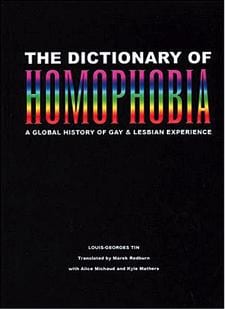A 500-page dictionary devoted to global homophobia? I can see the party boys running for the exits. How to explain that this unprecedented book, first published in France in 2003, is neither dull nor ultimately depressing? First of all, “dictionary” is a misnomer. It’s a comprehensive encyclopedia, the articles often running to several pages and dovetailing history, cultural studies and queer theory.
Scanning through editor Louis-Georges Tin’s tome (translated by Marek Redburn) I started where the bullying starts, with the entry titled “school.” In mid-19th-century France a police report noted that “acts of pederasty are very common between the wretched children of this boarding house.” I had to chuckle at the timeless cluelessness of this — the guardians of decency framing a mutual wank as an act of wretched desperation. Schools, as this six-page entry makes clear, are as often hotbeds of pleasure as gauntlets of shame. We’re reminded that in the British school system dorms have long been the site of homo trysts, with the ones who don’t get caught casually describing the unfortunates being disciplined “for the usual thing.”
Moving ahead to modern times we see freedom-fighters in US public schools get their due, using the courts to force equal access to queer-positive literature. The book quickly shows that it’s as much about our hidden (or wide open) acts of liberation over the centuries as it is about the seething moralists, whether they rule the playground or the Vatican.
The Sappho entry makes it clear that the famed love poet of ancient Lesbos has been a magnet for misrepresentation ever since Roman poet Ovid wrested her from the Greeks and reinvented her as the suicidal lover of a young boatman, Phaon. The conclusion: As a queer icon, Sappho still has a frustrating image problem. “Either the poet is construed as a lukewarm heterosexual [or] she is transformed into a sexually insatiable lesbian, which feeds homophobic stereotypes.” The implication is that we should all go back to the Sapphic font (the famous Fragment 31 is mentioned) and ignore the ensuing distortions of everyone from Ovid to Havelock Ellis.
The entry for Islam, running close to seven pages, will be an eye-opener for many. We know that Muslim dogma rivals the worst of Christian edicts, but Christelle Hamel’s article makes it clear that the dogmatists of Islam are as divorced from the prophet Muhammad as the Popes are from the teachings of Christ. The Koran is vague on homosexuality, leaving the later architects of sharia law free to ramp up the moralist outrage. Yet the Koran explicitly states that in Muslim paradise men are attended by buff “youths of perpetual freshness” along with their allotment of female virgins.
Hamel notes that Islamic jurisprudence has required for centuries that in cases of sexual transgression, a guilty verdict can be applied only with the testimony of four eyewitnesses to the deed — an impossibly high bar for obtaining convictions. The sentence of death by stoning for male-on-male sex (or any female sex outside marriage) has been possible through the ages only “by the arrangement of false testimonies or through extortion.” As in the Christian church it’s the patriarchs who call the shots, doling out their bigotry as divine justice.
Oscar Wilde is justly known as Britain’s first openly gay celebrity and a groundbreaking martyr to the cause of erotic freedom in Victorian England. Florence Tamagne’s entry states that Wilde’s trials and imprisonment under gross indecency laws “represented the height of Victorian-era homophobia and a crucial turning point in the history of homosexuality in Western society.” A condensed bio of Wilde outlines his bracingly impudent life and ends with the sensational trials, underscoring the revelatory shift that Wilde’s downfall triggered. By spurring huge media coverage and revealing an established urban gay sub-culture, the trials ensured that many isolated gay men “suddenly became conscious that they were part of a group.” It was an irreversible step toward a self-identified and self-empowered queer community.
A century later Matthew Shepard was martyred in a redneck corner of Wyoming, proving that segments of American society remain as brutally backward as the courtroom spectators spewing venom at Wilde. Tin’s entry on Shepard reminds us that his death was a prime factor in the passage by the Senate of the 2007 Matthew Shepard Act, identifying homophobia as a hate crime. George Bush, to no one’s surprise, has indicated he would veto the bill. Meanwhile Barack Obama has called its passage “a priority” in 2009. How he will square that with his antigay pal, evangelist mega-preacher Rick Warren, remains a mystery.

 Why you can trust Xtra
Why you can trust Xtra


